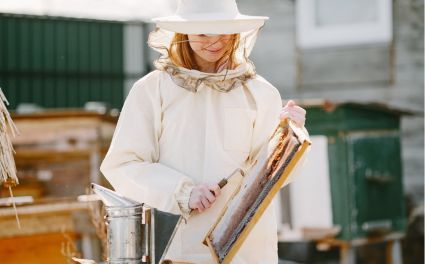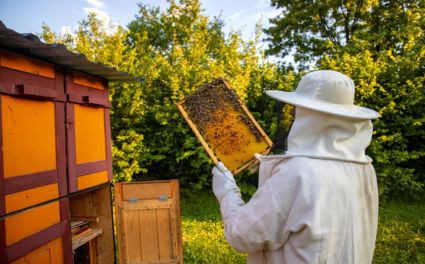Carpenter bees may look harmless, but these buzzing visitors can cause headaches for homeowners. Unlike honeybees or bumblebees, carpenter bees don’t live in hives. Instead, they burrow into exposed wood to build their nests, leaving behind neat, round holes that can weaken decks, siding, railings, and outdoor furniture.
While one or two holes may not seem like a big deal, over time, a carpenter bee infestation can create costly structural damage. To make matters worse, they often return to the same spot year after year.
The good news is you don’t have to resort to harmful chemicals. There are safe, eco-friendly ways to discourage these insects while still appreciating their role in pollination. Below, we’ll walk through 10 natural carpenter bee deterrents that can help you reclaim your home without harming the environment.
Understanding Carpenter Bees
Before you can prevent them, it helps to understand what makes carpenter bees tick.
-
Carpenter Bees vs Bumblebees: At first glance, they look similar, but carpenter bees have smooth, shiny abdomens while bumblebees appear fuzzy.
-
Why They Drill Holes: Female carpenter bees tunnel into wood to create galleries for laying eggs. These tunnels can stretch several inches deep, and multiple bees may expand the same tunnel over time.
-
Signs of Carpenter Bee Damage: Perfectly round holes about half an inch wide, little piles of sawdust, and buzzing activity near eaves or decks are red flags.
Knowing these basics makes it easier to spot early warning signs and apply the right carpenter bee repellent methods.

10 Natural Carpenter Bee Deterrents
1. Use Citrus Oil as a Natural Carpenter Bee Repellent
Carpenter bees dislike citrus. Boil lemon, lime, or orange peels in water, let the solution cool, and pour it into a spray bottle. Apply it to areas where you see activity—around deck railings, eaves, or porch furniture. Unlike chemicals, this homemade carpenter bee spray won’t harm pets or kids.
Tip: Reapply every few days during peak season for best results.
2. Apply Almond or Eucalyptus Oil on Wooden Surfaces
Another proven natural remedy is essential oils. Almond oil, eucalyptus, and peppermint have strong scents that act as a natural carpenter bee deterrent. Simply dip a cotton ball in the oil and wipe it over wooden beams or mix a few drops into water to create a spray.
Many homeowners find that this not only keeps carpenter bees away but also freshens the outdoor space.
3. Make a Homemade Carpenter Bee Spray
If you want something stronger, create a DIY spray using vinegar and essential oils. Mix one part white vinegar with three parts water, then add 10–15 drops of peppermint, tea tree, or citrus oil. Spray directly into holes and around problem areas.
This natural repellent works by irritating the bees’ senses, making the area less appealing. It’s one of the easiest and cheapest solutions for quick carpenter bee prevention.
4. Paint or Stain Exposed Wood to Protect Against Carpenter Bees
Bare wood is like an open invitation for carpenter bees. Painting or staining creates a barrier that discourages nesting. Use oil-based paint or varnish for long-lasting protection.
If you prefer a natural look, consider clear wood sealants. These not only help protect wood from carpenter bees but also guard against moisture and rot.
5. Seal Holes and Cracks in Wood
One of the best forms of prevention is maintenance. Inspect your deck, fence, or siding for cracks or small holes. Seal them with caulk or wood filler to eliminate potential entry points.
Closing off existing holes also prevents returning bees from reusing old tunnels. For extra protection, insert steel wool before sealing—it makes it harder for bees to chew through.
6. Hang Carpenter Bee Traps Near Active Areas
Traps are an effective, non-toxic way to reduce populations around your home. These wooden boxes mimic ideal nesting spots. Once bees enter, they get stuck and can’t escape.
While not strictly “natural,” traps are pesticide-free and safe for the environment. Hang them near problem areas to draw bees away from your home.
7. Use Noise Deterrents Like Wind Chimes or Ultrasonic Devices
Carpenter bees dislike vibrations and constant noise. Hanging wind chimes around porches or using ultrasonic devices can create an environment that feels hostile to them.
This is a great method if you want a carpenter bee deterrent that doubles as yard décor.
8. Provide Alternative Nesting Sites
Sometimes, the easiest solution is redirecting their behavior. Place untreated blocks of softwood a few feet away from your house. Carpenter bees are naturally drawn to bare wood and may choose the decoy instead of your siding.
Over time, this reduces the risk of carpenter bee infestation in your valuable structures.
9. Plant Bee-Friendly Flowers Away From Your Home
Carpenter bees play an important role in pollination, so you don’t want to eliminate them completely. By planting flowers like lavender, salvia, or sunflowers at a distance from your house, you give them a food source away from vulnerable wood.
This balance allows you to enjoy their pollination benefits while keeping your deck, shed, and railings safe.
And if you’re into backyard beekeeping, pairing pollinator plants with protective gear such as beekeeping jackets, beekeeping suits, or beekeeping gloves ensures a safe and rewarding experience.
10. Regularly Inspect and Maintain Wooden Structures
Routine maintenance is one of the most overlooked yet powerful strategies. Sand down rough wood, repaint when needed, and check for early signs of carpenter bee damage each season.
If you’re already working around bees, consider protective essentials such as beekeeping veils, beekeeping trousers, or even kids’ beekeeping suits so the whole family can stay safe. Adding beekeeping ankle protection is also a smart move when dealing with buzzing activity around hives or gardens.
When to Call a Professional
Natural methods are usually enough to repel carpenter bees, but in severe cases, professional help may be required. If you notice multiple nests, widespread holes, or structural damage, it’s wise to call a pest control expert.
Professionals use specialized treatments to safely handle carpenter bee nest removal without harming the environment. This ensures both your home and the local ecosystem are protected.

Conclusion
Carpenter bees may cause frustration, but they’re also vital pollinators. By using natural carpenter bee deterrents like essential oils, citrus sprays, traps, and proper maintenance, you can protect your wood structures without resorting to harsh chemicals.
The key is consistency—apply these methods regularly, especially during spring and summer when carpenter bee activity is highest. With these 10 natural ways to repel carpenter bees from your home, you’ll enjoy a safer, damage-free environment while still respecting nature.
If you’re passionate about learning more, check out OZ Armour, a trusted name for protective gear and supplies, or read more blogs about beekeeping to expand your knowledge.












